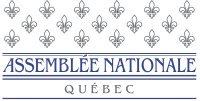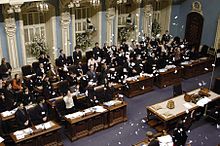- National Assembly of Quebec
-
"Blue Chamber" redirects here. For other uses, see Blue Room (disambiguation).
National Assembly of Quebec
Assemblée nationale du Québec
Type Type Unicameral Houses National Assembly Leadership President Jacques Chagnon, Liberal
since April 5, 2011Structure Members 125 members of Assembly 
Political groups PLQ (65)
PQ (46)
ADQ (4)
QS (1)
Independent (9)Meeting place 
Parliament Building, Quebec City Website www.assnat.qc.ca The National Assembly of Quebec (French: Assemblée nationale du Québec) is the legislative body of the Province of Quebec. The Lieutenant Governor and the National Assembly compose the Parliament of Quebec, which operates in a fashion similar to those of other British-style parliamentary systems.
The National Assembly was formerly the lower house of Quebec's legislature and was then called the Legislative Assembly of Quebec. In 1968, the upper house, the Legislative Council, was abolished and the remaining house was renamed.
The current President of the National Assembly is Liberal Member of the National Assembly (MNA) Jacques Chagnon.
Contents
History
The Legislative Assembly was created in Lower Canada by the Constitutional Act of 1791. It was abolished from 1841 to 1867 under the 1840 Act of Union which merged Upper Canada and Lower Canada into a single colony named the Province of Canada.
The Constitution Act, 1867, which created Canada, split the Province of Canada into the Provinces of Quebec and Ontario. The Legislative Assembly of Lower Canada was thus restored as the Legislative Assembly of the Province of Quebec.
The original Quebec legislature was bicameral, consisting of the Legislative Council and the Legislative Assembly.
In 1968, Bill 90 was passed by the government of Premier Jean-Jacques Bertrand, abolishing the Legislative Council and renaming the Legislative Assembly the "National Assembly". Before 1968, there had been various unsuccessful attempts at abolishing the Legislative Council, which was analogous to the Senate of Canada.
In 1978, television cameras were brought in for the first time to televise parliamentary debates. The colour of the walls was changed to suit the needs of television and the salon vert (green hall) became the salon bleu (blue hall).
Parliament Building
Main article: Parliament BuildingThe present Parliament Building was designed by architect Eugène-Étienne Taché and has been the home of the provincial parliament since 1886. Its Second Empire architectural style is unique among legislative buildings in Canada, where this style never reached the same level of popularity it enjoyed in continental Europe and the United States during the same period. Its façade features a pantheon representing important events and people in the history of Quebec.
This building replaced the old Parliament at Parc Montmorency, destroyed in a fire in 1883.
Elections
General elections are held every five years or less. Any person holding Canadian citizenship and who has resided in Quebec for at least six months qualifies to be on the electoral list.
Normally, the leader of the political party with the largest number of elected candidates is asked by the Lieutenant-Governor of Quebec to form the government as premier. (In French, it is rendered as premier ministre. The term "prime minister" is commonly used by the government as a literal translation of the French term.).
Quebec's territory is divided into 125 electoral districts (ridings). In each riding, the candidate who receives the most votes is elected and becomes a Member of the National Assembly (MNA). This is known as the first-past-the-post voting system. It tends to produce strong disparities in the number of seats won compared to the popular vote, perhaps best exemplified by the 1966, 1970, and 1973 elections.
Quebec elections have also tended to be volatile since the 1970s, producing a large turnover in Assembly seats. Consequently, existing political parties often lose more than half their seats with the rise of new or opposition political parties. For instance, the 1970 and 1973 saw the demise of the Union Nationale and rise of the Parti Québécois which managed to take power in 1976. The 1985 and 1994 elections saw the Liberals gain and lose power in landslide elections.
Current members
Main article: 39th National Assembly of QuebecMost recent election
Summary of the December 8, 2008 National Assembly of Quebec election results Party Party leader Candi-
datesSeats Popular vote 2007 Dissol. 2008 Change % # % Change Liberal Jean Charest 125 48 48 66 +18 52.80% 1,366,046 42.08% +9.00% Parti québécois Pauline Marois 125 36 36 51 +15 40.80% 1,141,751 35.17% +6.82% Action démocratique du Québec Mario Dumont 125 41 39 7 -34 5.60% 531,358 16.37% -14.47% Québec solidaire Françoise David
Amir Khadir†122 - - 1 +1 0.80% 122,618 3.78% +0.14% Green Guy Rainville 80 - - - - - 70,393 2.17% -1.68% Parti indépendantiste Éric Tremblay 19 * - - * - 4,227 0.13% * Marxist-Leninist Pierre Chénier 23 - - - - - 2,727 0.08% +0.03% Durable Sébastien Girard 1 * - - * - 567 0.02% * Republic of Quebec Gilles Paquette 1 * - - * - 140 <0.01% * Independents 30 - - - - - 6,506 0.20% +0.09% Vacant 2 Total 651 125 125 125 - 100% 3,246,333 100% Notes: - "Change" refers to change from previous election.
- † The party designates David and Khadir as co-spokespeople; the de jure leader recognized by the Directeur général des éléctions is Benoît Renaud.
- * Party did not nominate candidates in the previous election.
Proceedings
One of the members of the National Assembly is chosen as the President of the Assembly (a post called Speaker in most other Westminster System assemblies) by the Premier with the support of the Leader of the Opposition. The President of the Assembly is the arbiter of the parliamentary debates between the members of the government and the members of the Opposition. In order for a member to address a member of the other side, he or she has to speak through the President of the Assembly. The President is usually a member of the governing party, although there is no requirement for this.
The proceedings of the National Assembly are broadcast across Quebec on the cable television network Canal de l'Assemblée nationale.
See also
- Executive Council of Quebec
- List of Quebec general elections
- List of Quebec premiers
- List of Quebec leaders of the Opposition
- Politics of Quebec
- Timeline of Quebec history
References
- Assemblé nationale du Québec (2000). What is the National Assembly?, Québec: Assemblée nationale, 58 p. (ISBN 2-550-30165-X)
- Deschênes, Gaston (1983). The Assemblée nationale: Its Organization and Parliamentary Procedure, Québec: Assemblée nationale, 53 p. (ISBN 2551047595) [1st ed. in 1977]
External links
- National Assembly of Quebec website (French) (English)
- National Assembly historical data (French)
- Diagram of the positions in the Assembly (French)
- Data about the current president of the Assembly
 Canadian Legislative Bodies
Canadian Legislative BodiesParliament of Canada Legislative assemblies Alberta • British Columbia • Manitoba • New Brunswick • Newfoundland and Labrador • Northwest Territories • Nova Scotia • Nunavut • Ontario • Prince Edward Island • Quebec • Saskatchewan • Yukon
City councils Abbotsford • Barrie • Brampton • Brantford • Burlington • Burnaby • Calgary • Cambridge • Cape Breton • Charlottetown • Chatham-Kent • Coquitlam • Edmonton • Fredericton • Gatineau • Greater Sudbury • Guelph • Halifax • Hamilton • Iqaluit • Kingston • Kitchener • Laval • Lévis • London • Longueuil • Markham • Mississauga • Moncton • Montreal • Niagara Falls • North Bay • Oakville • Oshawa • Ottawa • Quebec City • Regina • Richmond • Richmond Hill • St. Catharines • Saint John • St. John's • Saanich • Saguenay • Saskatoon • Sault Ste. Marie • Sherbrooke • Surrey • Thunder Bay • Toronto • Vancouver • Vaughan • Victoria • Whitby • Whitehorse • Windsor • Winnipeg • Yellowknife
Legislative Assemblies of Quebec
1st (1867-1871) · 2nd (1871-1875) · 3rd (1875-1878) · 4th (1878-1881) · 5th (1881-1886) · 6th (1886-1890) · 7th (1890-1892) · 8th (1892-1897) · 9th (1897-1900) · 10th (1900-1904) · 11th (1904-1908) · 12th (1908-1912) · 13th (1912-1916) · 14th (1916-1919) · 15th (1919-1923) · 16th (1923-1927) · 17th (1927-1931) · 18th (1931-1935) · 19th (1935-1936) · 20th (1936-1939) · 21st (1939-1944) · 22nd (1944-1948) · 23rd (1948-1952) · 24th (1952-1956) · 25th (1956-1960) · 26th (1960-1962) · 27th (1962-1966)National Assemblies of Quebec
28th (1966-1970) · 29th (1970-1973) · 30th (1973-1976) · 31st (1976-1981) · 32nd (1981-1985) · 33rd (1985-1989) · 34th (1989-1994) · 35th (1994-1998) · 36th (1998-2003) · 37th (2003-2007) · 38th (2007-2008) · 39th (2008-)Categories:- Government of Quebec
- National Assembly of Quebec
- Unicameral legislatures
Wikimedia Foundation. 2010.
